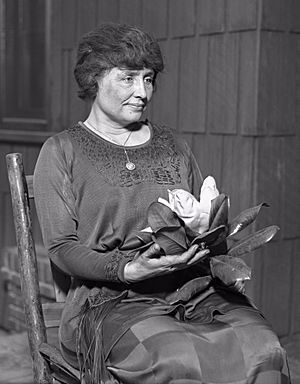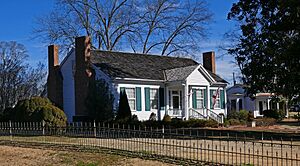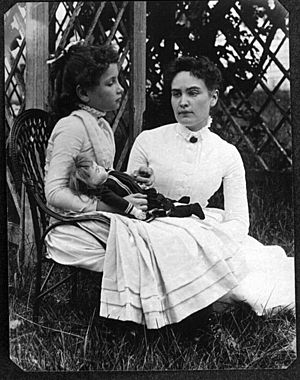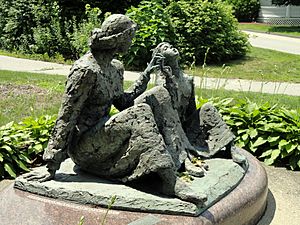Helen Keller facts for kids
Quick facts for kids
Helen Keller
|
|
|---|---|

Keller holding a magnolia, c. 1920
|
|
| Born | Helen Adams Keller June 27, 1880 Tuscumbia, Alabama, U.S. |
| Died | June 1, 1968 (aged 87) Easton, Connecticut, U.S. |
| Resting place | Washington National Cathedral |
| Occupation |
|
| Education | Radcliffe College (BA) |
| Notable works | The Story of My Life (1903) |
| Signature | |
Helen Adams Keller (born June 27, 1880 – died June 1, 1968) was an amazing American author, speaker, and activist. She worked hard to support the rights of people with disabilities. Even though she was deaf and blind, Helen went to Radcliffe College at Harvard University. She was the first deaf-blind person in the United States to earn a Bachelor of Arts degree. Time magazine even named her one of the 100 Most Important People of the 20th Century!
Contents
- Helen Keller's Early Life and Illness
- Learning to Communicate
- Helen's Formal Education
- Helen's Companions
- Career, Writing, and Activism
- Personal Life
- Helen Keller's Works
- Later Life and Death
- Famous Quotes by Helen Keller
- Interesting Facts About Helen Keller
- Portrayals of Helen Keller's Life
- Honors After Her Death
- See also
Helen Keller's Early Life and Illness


Helen Keller was born on June 27, 1880, in Tuscumbia, Alabama. Her parents were Arthur Henley Keller and Catherine Everett (Adams) Keller. Her family lived on a homestead called Ivy Green. Helen had four siblings.
When Helen was just 19 months old, she became very sick. This illness caused her to lose both her eyesight and her hearing. Doctors at the time didn't know what it was, but some believe it might have been scarlet fever or meningitis. Helen later described this time in her life as living "at sea in a dense fog."
Because she couldn't communicate easily, Helen sometimes became very frustrated and angry. She could communicate a little with Martha Washington, the family cook's daughter, using simple signs. By age seven, Helen had learned over 60 home signs to talk with her family. She could even tell people apart by feeling the vibrations of their footsteps!
Around this time, Helen's mother learned about a successful deaf and blind woman named Laura Bridgman. This inspired her to find a teacher for Helen. Following the advice of Alexander Graham Bell, who worked with deaf children, she contacted the Perkins Institute for the Blind. The school's director, Michael Anagnos, asked Anne Sullivan, a 20-year-old visually impaired former student, to teach Helen. This was the start of a nearly 50-year friendship. Anne became Helen's teacher and later her close companion.
Learning to Communicate
Anne Sullivan arrived at Helen's home on March 5, 1887. Helen always remembered this day as "my soul's birthday." Anne immediately started teaching Helen to communicate by spelling words into her hand. She began with "d-o-l-l" for a doll she brought as a gift.
At first, Helen didn't understand that each object had a specific word. Once, when Anne tried to teach her the word for "mug," Helen got so upset that she broke the mug. But soon, Helen started to copy Anne's hand gestures.
A month later, Helen had a big breakthrough. Anne was spelling "w-a-t-e-r" into one of Helen's hands while cool water flowed over her other hand. Suddenly, Helen understood! She realized that the hand motions meant the cool liquid.
In her autobiography, The Story of My Life, Helen wrote about that moment:
I stood still, my whole attention fixed upon the motions of her fingers. Suddenly I felt a misty consciousness as of something forgotten—a thrill of returning thought; and somehow the mystery of language was revealed to me. I knew then that w-a-t-e-r meant the wonderful cool something that was flowing over my hand. The living word awakened my soul, gave it light, hope, set it free!
After this, Helen quickly wanted Anne to sign the names of all the other familiar objects around her.
Helen's Formal Education
- In May 1888, Helen started attending the Perkins Institute for the Blind.
- In 1894, Helen and Anne moved to New York. There, Helen attended the Wright-Humason School for the Deaf and learned from Sarah Fuller at the Horace Mann School for the Deaf.
- In 1896, they returned to Massachusetts. Helen then enrolled at The Cambridge School for Young Ladies.
- In 1900, she was accepted into Radcliffe College at Harvard University.
- In 1904, at age 24, Helen graduated from Radcliffe. She became the first deaf-blind person to earn a Bachelor of Arts degree.
Helen's Companions
Anne Sullivan remained Helen Keller's companion long after she finished teaching her. Anne married John Macy in 1905. Later, Anne's health began to decline. In 1914, Polly Thomson (1885–1960) was hired to help with the household. Polly was a young woman from Scotland who had no experience with deaf or blind people. She soon became Helen's secretary and then her constant companion.
Helen, Anne, and John Macy lived together in Forest Hills, Queens. Helen used their home to support the American Foundation for the Blind.
Anne Sullivan passed away in 1936, with Helen holding her hand. After Anne's death, Helen and Polly moved to Connecticut. They traveled all over the world, raising money and awareness for blind people. Polly had a stroke in 1957 and died in 1960. Winnie Corbally, a nurse hired to care for Polly, stayed on and became Helen's companion for the rest of her life.
Career, Writing, and Activism
Helen Keller quickly became a world-famous speaker and author. She was a strong advocate for people with disabilities and many other causes.
She traveled to 25 different countries, giving inspiring speeches about the lives of deaf people. She supported women's right to vote, was a pacifist (someone who believes in peace, not war), and a socialist. In 1915, she helped start the Helen Keller International (HKI) organization. This group works on research for vision, health, and nutrition.
In 1909, Helen joined the Socialist Party of America. She believed that everyone should have fair opportunities. In 1916, she sent money to the NAACP. She felt ashamed of how "colored people" were treated in the Southern United States.
In 1920, Helen helped create the American Civil Liberties Union (ACLU), which protects people's rights. She traveled to over 40 countries with Anne Sullivan, visiting Japan many times, where she was very popular.
Helen worked for the American Foundation for the Blind (AFB) from 1924 until 1968. From 1946 to 1957, she visited 35 countries, speaking up for those with vision loss.
Personal Life
When Helen was in her thirties, she wanted to marry a socialist reporter named Peter Fagan. He was her private secretary when Anne was ill. However, her family and Anne Sullivan strongly disagreed with her marriage. They believed that women with disabilities should not marry. Because of this, the engagement was called off, and Helen never married or had children.
Helen Keller's Works
Helen Keller was a very productive writer. She wrote 14 books and hundreds of speeches and essays. Her topics ranged from animals to Mahatma Gandhi.
At age 22, Helen published her autobiography, The Story of My Life (1903). Anne Sullivan and Anne's husband, John Macy, helped her. The book tells the story of her life up to age 21 and was written while she was in college. This book was later made into a play and a movie called The Miracle Worker.
In 1908, Helen wrote The World I Live In. This book helped readers understand how she experienced the world around her.
Helen Keller's Writings
- "The Frost King" (1891)
- The Story of My Life (1903)
- Optimism: an essay (1903)
- The World I Live In (1908)
- Out of the Dark, essays on socialism (1913)
- My Religion (1927; also called Light in My Darkness)
- Midstream: my later life (1929)
- Teacher: Anne Sullivan Macy: a tribute by the foster-child of her mind. (1955)
- The open door (1957)
Later Life and Death
Helen Keller had several strokes starting in 1961. She spent her last years at her home.
Helen dedicated much of her later life to raising money for the American Foundation for the Blind. She passed away peacefully in her sleep on June 1, 1968, at her home in Easton, Connecticut. She was almost 88 years old. A service was held at the Washington National Cathedral in Washington, D.C. Her ashes were buried there next to her dear companions, Anne Sullivan and Polly Thomson.
Famous Quotes by Helen Keller
- "We are never really happy until we try to brighten the lives of others."
- "We live by each other and for each other. Alone we can do so little; together we can do so much."
- "Keep your face to the sunshine and you cannot see the shadows."
- "The true test of a character is to face hard conditions with the determination to make them better."
Interesting Facts About Helen Keller
- Helen had Swiss ancestors. One of them was the first teacher for the deaf in Zürich.
- Her family was rich.
- Helen could enjoy music by feeling the beat and had a strong connection with animals through touch.
- Even though she had trouble learning language at first, she found her voice.
- Mark Twain admired Helen greatly. He introduced her to Standard Oil leader Henry Huttleston Rogers, who, with his wife, paid for Helen's education.
- She exchanged letters with Austrian philosopher Wilhelm Jerusalem, who recognized her writing talent early on.
- At age 11, she wrote "The Frost King" (1891). Some people thought parts of it were similar to another story.
- Helen was determined to communicate as much as possible. She learned to speak and spent much of her life giving speeches.
- She learned to "hear" people's speech using the Tadoma method. This meant using her fingers to feel the lips and throat of the person speaking.
- She became very good at using braille and fingerspelling to communicate.
- Before World War I, she discovered she could experience music by placing her fingertips on a vibrating tabletop.
- Helen met every U.S. president from Grover Cleveland to Lyndon B. Johnson. She was also friends with famous people like Alexander Graham Bell and Charlie Chaplin.
- On September 14, 1964, President Lyndon B. Johnson gave her the Presidential Medal of Freedom. This is one of the highest awards a civilian can receive in the U.S.
- In 1965, she was chosen for the National Women's Hall of Fame.
- Helen Keller's birthplace is now a National Historic Landmark and a museum. It hosts an annual "Helen Keller Day."
Portrayals of Helen Keller's Life
Helen Keller's life story has been told many times in different ways.
- She appeared in a silent film called Deliverance (1919).
- She was the subject of the 1954 documentary Helen Keller in Her Story, which won an Academy Award.
- The Miracle Worker is a famous series of plays and films based on her autobiography. These stories show the special relationship between Helen and Anne Sullivan. They highlight how Anne helped Helen go from a wild state to becoming educated and famous. The title "The Miracle Worker" comes from Mark Twain's description of Anne Sullivan.
- The first version was a 1957 TV play by William Gibson.
- It was adapted for Broadway in 1959 and then for an Oscar-winning movie in 1962. Anne Bancroft played Anne Sullivan, and Patty Duke played Helen.
- It was remade for television in 1979 and 2000.

- An anime movie called The Story of Helen Keller: Angel of Love and Light was made in 1981.
- In 1984, a TV movie called The Miracle Continues told the story of her college years and early adult life.
- The Bollywood movie Black (2005) was largely based on Helen Keller's story.
- A documentary called Shining Soul: Helen Keller's Spiritual Life and Legacy (2005) focused on how her spiritual beliefs inspired her.
- In 2008, a rare 1888 photograph of Helen and Anne was discovered. It is believed to be the earliest photo of Anne Sullivan Macy.
- Video footage exists showing Helen Keller speaking.
- In 2020, the documentary Her Socialist Smile by John Gianvito explored Helen's public talks about progressive causes.
Honors After Her Death

Helen Keller has received many honors even after her death:
- In 1999, she was listed in Gallup's Most Widely Admired People of the 20th century.
- Also in 1999, Time magazine named her one of the 100 Most Important People of the 20th Century.
- In 2003, Alabama honored her on its state quarter. This quarter is the only U.S. coin in circulation that features braille.
- The Helen Keller Hospital in Sheffield, Alabama, is named after her.
- Streets are named after Helen Keller in places like Zürich, Switzerland; Getafe, Spain; Lod, Israel; Lisbon, Portugal; and Caen, France.
- A preschool for the deaf and hard of hearing in Mysore, India, was originally named after her.
- In 1980, the United States Postal Service issued a stamp showing Keller and Sullivan to celebrate the 100th anniversary of Helen's birth.
- On October 7, 2009, the State of Alabama donated a bronze statue of Keller to the National Statuary Hall Collection in Washington, D.C.
See also
 In Spanish: Helen Keller para niños
In Spanish: Helen Keller para niños





